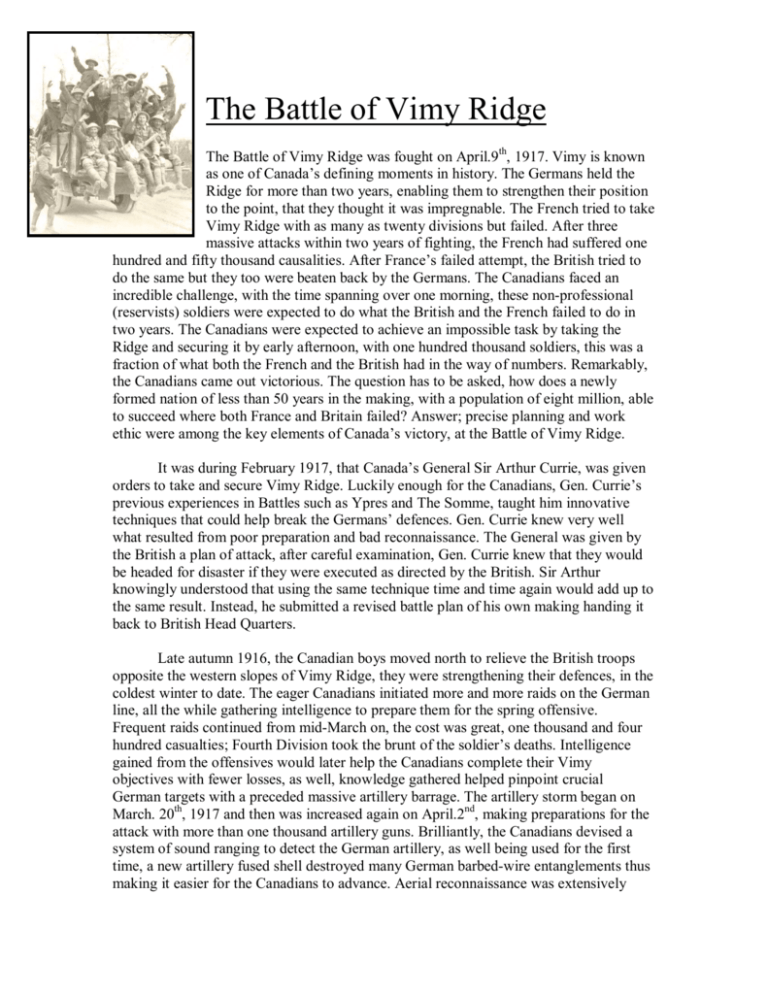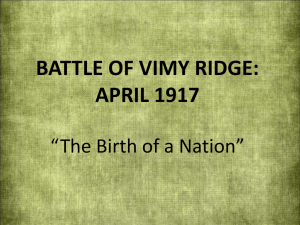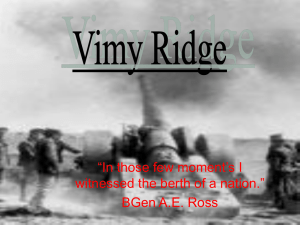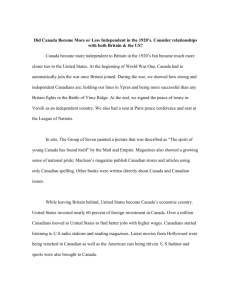Vimy Ridge Essay Final WITH PIC
advertisement

The Battle of Vimy Ridge The Battle of Vimy Ridge was fought on April.9th, 1917. Vimy is known as one of Canada’s defining moments in history. The Germans held the Ridge for more than two years, enabling them to strengthen their position to the point, that they thought it was impregnable. The French tried to take Vimy Ridge with as many as twenty divisions but failed. After three massive attacks within two years of fighting, the French had suffered one hundred and fifty thousand causalities. After France’s failed attempt, the British tried to do the same but they too were beaten back by the Germans. The Canadians faced an incredible challenge, with the time spanning over one morning, these non-professional (reservists) soldiers were expected to do what the British and the French failed to do in two years. The Canadians were expected to achieve an impossible task by taking the Ridge and securing it by early afternoon, with one hundred thousand soldiers, this was a fraction of what both the French and the British had in the way of numbers. Remarkably, the Canadians came out victorious. The question has to be asked, how does a newly formed nation of less than 50 years in the making, with a population of eight million, able to succeed where both France and Britain failed? Answer; precise planning and work ethic were among the key elements of Canada’s victory, at the Battle of Vimy Ridge. It was during February 1917, that Canada’s General Sir Arthur Currie, was given orders to take and secure Vimy Ridge. Luckily enough for the Canadians, Gen. Currie’s previous experiences in Battles such as Ypres and The Somme, taught him innovative techniques that could help break the Germans’ defences. Gen. Currie knew very well what resulted from poor preparation and bad reconnaissance. The General was given by the British a plan of attack, after careful examination, Gen. Currie knew that they would be headed for disaster if they were executed as directed by the British. Sir Arthur knowingly understood that using the same technique time and time again would add up to the same result. Instead, he submitted a revised battle plan of his own making handing it back to British Head Quarters. Late autumn 1916, the Canadian boys moved north to relieve the British troops opposite the western slopes of Vimy Ridge, they were strengthening their defences, in the coldest winter to date. The eager Canadians initiated more and more raids on the German line, all the while gathering intelligence to prepare them for the spring offensive. Frequent raids continued from mid-March on, the cost was great, one thousand and four hundred casualties; Fourth Division took the brunt of the soldier’s deaths. Intelligence gained from the offensives would later help the Canadians complete their Vimy objectives with fewer losses, as well, knowledge gathered helped pinpoint crucial German targets with a preceded massive artillery barrage. The artillery storm began on March. 20th, 1917 and then was increased again on April.2nd, making preparations for the attack with more than one thousand artillery guns. Brilliantly, the Canadians devised a system of sound ranging to detect the German artillery, as well being used for the first time, a new artillery fused shell destroyed many German barbed-wire entanglements thus making it easier for the Canadians to advance. Aerial reconnaissance was extensively used to make for a better plan of attack. Fighter aircraft played an integral role as well. Allied planes prevented the enemy from discovering the Canadian plans by shooting down German observation balloons. This was important and treacherous work; enemy airships were guarded by fighters and anti-aircraft guns. Engineering played a major role. The British, French, and German Engineers had all tunnelled under “No Man’s Land” filling the tunnels up with explosives, then later blowing them up, resulting in massive crater-like holes in the battlefield impeding the advancement of the soldiers. Ingeniously, the Canadians not only used existing British and French tunnels but also excavated new tunnels calling them subways. Clandestinely they worked at night, to avoid the attention of the Germans. Tunnelling companies dug twelve deep subways. These were used by assault troops, moving them up to their jumping –off points deeper into enemy territory. These subways protected the Canadians from artillery and allowed the wounded to be brought back from the battlefield. One subway in particular, called the “Goodman” was 1.2 kilometres long. All of these tunnels had piped water, telephones lines, and most were lit by electricity provided by generators. These subways contained battalion headquarters, ammunition and communication centers along with dressing stations. There were several large caverns but the largest was the “Zivy Cave”, capable of holding a whole battalion. Saps, being, smaller tunnels leading from the subways to the front line, were very useful, as a charge was set off making an open end at Zero Hour enabling Canadian soldiers to travel through them on to enemy lines. These tunnels and caverns were expertly used by the Canadians and were pivotal in the success of Vimy. Above ground, Canadian and British Engineers restored forty kilometres of roads and added another five kilometres of new plank road. These Engineers also repaired thirty-two kilometres of light railway importantly needed to carry stores and ammunition to the front line. General Currie gave orders to build a full scale replica of the battlegrounds. It was laid out with detailed coloured tape and flags, positions and topography to scale. The Men carried out repeated exercises, rehearsing exactly what they would do throughout the day of attack. This was the first battle that every soldier was issued maps, normal protocol was to only issue maps to Senior Non Commissioned Officers. Wisely every soldier knew their task and the proper route they should take, this added greatly to the success of the troops being when a Non Commissioned Officer was killed, the soldiers could still carry out their objective. Preparations for Vimy were significant to Canada’s success. To illustrate, in contrast to the French and Brits, great haste was used to get the job done. Both Countries used the same battle strategies as used a hundred years prior, throwing wave after wave of soldiers at the enemy. War now in 1917 was different, now a defensive posture, and not an offensive one. Germany knew this in advance therefore giving them the upper hand; they took time to place machine gun nests and barbed-wire. Canadians understood the situation and adapted quickly to the new warfare which led to the Germans defeat. Highlighting some of the events that happened starting on April 9th, at 5:30 am, on an Easter Monday, all four Canadian Divisions advanced in line. First Division was opposite to the town of Thélus and Fourth Division was facing the all important Hill 145. Canadian troops hurried behind a creeping barrage, this was a very difficult and new tactic. Troops had to be far enough away from the pounding shells, but also not lag too far behind; the result would be slowing the tempo of attack. This barrage destroyed the rest of the heavily fortified trenches and barbed-wire. Third Division was sliced into by the German machine-gunners, when the Officers and Sergeants were killed, Corporals and Privates took the helm. Two battalions of the Second Division took one hundred fifty German prisoners, including a German Colonel. Captain Thain MacDowell of the Twenty Eighth Regiment personally knocked out two machine guns and persuaded seventy-seven Prussian Guards to surrender. Captain MacDowell won the Victoria Cross, and was the only one out of the four recipients at Vimy that survived the war. Fourth Division had some of the hardest objectives and it was made even tougher because two of its battalions had almost been decimated in the intelligence gathering raids prior to the Vimy Attack, worst being on March.1st. Facing Hill 145, this Division had to attack the highest ground and the most heavily German defended part of the Ridge. To assist the Fourth Division, the Colonel from the Eighty-Seventh Regiment told the artillery to leave one of the trenches intact, the intent was to leave cover for the Fourth Division, unfortunately the trench was full of German soldiers. After this battle, the Nova Scotia Battalion held in Reserve, was sent to the front line to assist the Fourth Division. They bravely fought along side the survivors of Division Four to take Hill 145, a key objective. Three days later on April.12th, 18 artillery batteries and the 10th Brigade took yet another key objective on the Ridge “The Pimple”. Importantly part of the success of the Canadians were the character of the Men and Officers. To background these brave soldiers, they came from pioneer stock, working on farms and opening up this great country of ours. These soldiers were men who had settled all across this land, they were used to hard work, long hours, and less than ideal conditions. During the lead up to the Vimy Battle, much time was spent on back-breaking digging and carrying heavy loads over difficult ground. These tough boys adapted easily to these somewhat familiar conditions, making the best out of the worst. As the renowned author Pierre Berton said; “These men whose arms and shoulder muscles had been toughened by years of playing the two indigenous Canadian games, lacrosse and ice hockey.” (Vimy, p.28). It was no great feat for the Canadians to march for hours with a rifle and a one hundred pound ruck-sack. These men of craft were also skilled teamsters, horses were the backbone of the Canadian Army, and fifty thousand were used in supplying ammunition and supplies as well pulling artillery guns. Our Canadians came from across fertilization of the labour force, the railway, the mines, forestry, and of course farms. All these acquired skills were an asset and fit nicely into the Vimy requirements. Thousands of feet of rail and plank roads had to be laid, hundreds of feet of tunnel had to be blasted from the chalk. Living conditions in the trenches were appalling, but at least most of the Canadians at Vimy had known what it is like to sleep out in the mud and rain at one time or another, also to eat a cold meal in the wilderness was not a strange ordeal for most of them, Canadians adjusted to the abhorrent conditions better than the rest. There shooting skills were unmatched as it was second nature for most to feel very comfortable with a rifle. To emphasize the Nationalism displayed at Vimy, visualize these Canadians loaded down with equipment, a lot wounded and drowning in mud, most creeping forward hugging the deafening barrage of artillery shells. Most of these boys were frightened beyond belief, but more importantly, every man was more afraid of showing fear than he was of the enemy guns. Nobody stayed behind, that was not possible. This was the fortitude that the Canadians displayed. They all had guts; they all fought as one, it was an unmatched espirts des corps. At the Ridge, it was the first time all four Canadian divisions fought together. The thought of being Canadian and not so much British was infectious. Besides, they wanted to prove to the Brits that they were as good, if not better, as they were always looked down upon by the professional English soldiers. “They had been gassed at Ypres and blooded at the Somme, and the shoulder badge “Canada” had made them all brothers, no matter what their language or region.” (Vimy, p.17). Canada entered the war as a junior partner with Great Britain and emerged as an equal. Vimy Ridge was an important turning point in Canada’s history. These men, who had fought so valiantly, were among the brightest and the toughest are land had to offer. No one soldier was spot lighted as an overall hero in the Canadian Corps, they instead worked as a strong unit; this was orchestrated by the Officer Corps to make sure that the fighting force was strong from the bottom up and not from the top down. This was a new concept and made the bonding between Officers and Men stronger than any other Army. Yes, we were a country, but what is a country? This was the first opportunity to rally together from all provinces in such great numbers since 1867, yes there was the Boer War but the numbers were small in comparison to WWI and Vimy and for the first time we were under command of a Canadian Brigadier General and not a British Field Marshall. For once united, from one end of the land to the other, brothers in arms we could nail down our Nationalism. Vimy was fought with Canadians, plans were devised by Canadians, and for once we took center stage in the world. To quote from Brigadier General A.E. Ross, “In those few minutes I witnessed the birth of a nation.” Name: Liam Ryan Teacher: Mr. Zander Date Submitted: March. 5th, 2007







